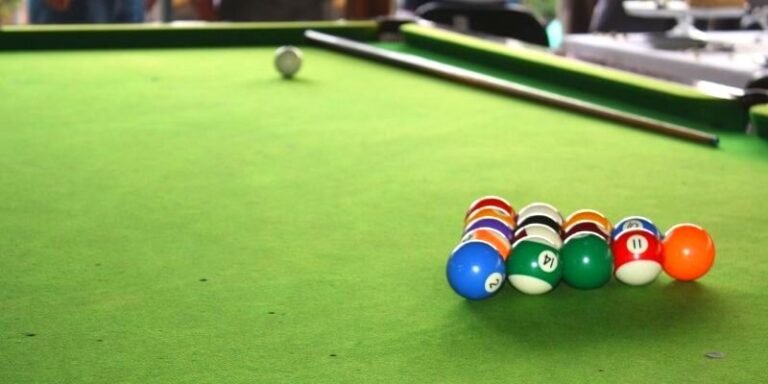How to Move a Pool Table Without Breaking the Slate?

Moving a pool table is a challenging task that requires careful planning and execution to avoid damaging the delicate slate.
Whether you’re relocating to a new home or simply moving the table to another room, understanding the process is crucial to ensure the safety of both the movers and the pool table itself.
This comprehensive guide will walk you through the steps to move your pool table safely, ensuring that the slate remains undamaged throughout the process.
Key Takeaways
- Preparation is crucial: Gather all necessary tools and materials before starting.
- Disassembly is essential: Carefully disassemble the table to protect the slate.
- Proper handling and transportation: Use appropriate techniques to move and transport the slate.
- Reassembly and leveling: Ensure the table is correctly reassembled and leveled at the new location.
Understanding the Structure of a Pool Table
A pool table is more than just a playing surface; it’s a complex piece of furniture comprising several parts, including:
- Slate: The heavy, flat playing surface.
- Felt: The cloth covering the slate.
- Rails: The sides of the table where balls rebound.
- Frame: Supports the slate and includes legs.
Understanding this is crucial in determining the feasibility of moving it without disassembly or breaking the slate.
Understanding Your Pool Table
Different pool tables have different construction and disassembly methods.
There are different types of pool tables, both slate and non slate, and moving slate is much harder given the weight involved.
- The slate is the heart of the pool table, and it’s a heavy, flat stone that provides a smooth playing surface.
- Its weight contributes significantly to the overall mass of the table, making moving a slate pool table a challenging task.
Familiarize yourself with your specific model, especially how the slate is secured and the best way to handle it.
Preparing for the Move
Before moving your pool table, it’s important to assess the situation.
- Measure the dimensions of your pool table and the path you’ll take to move it.
- Check for any obstacles that might hinder the move, such as narrow doorways or stairs.
When you have the measurements to hand, you will also know whether it’s an option to move the pool table without disassembling it first.
Gathering the Necessary Tools
Before you begin, ensure you have all the necessary tools.
The tools you will need are:
- A staple remover
- A Flathead screwdriver
- A power drill
- A Socket wrench
- Large tarps or moving blankets
- A dolly
- A measuring tape
Disassembling Your Pool Table
To safely move a pool table without breaking the slate, disassembling it is the safest option.
To dissemble a pool table, you will need to:
- Removing the Felt – Carefully remove the staples or glue holding the felt in place and fold the felt gently to avoid creases.
- Taking Apart the Rails and Pockets – Unscrew the rails from the table and remove the pockets, which may be stapled or screwed in.
- Removing the Slate – Slate is extremely heavy but also fragile, so carefully remove screws and lift each piece carefully.
- Dismantle the Frame – Depending on the table, you may need to dismantle the frame according to the user manual of your individual pool table.
Moving the Slate
Protecting the Slate is of utmost importance because it is extremely expensive to replace and if one piece needs to be replaced, all three pieces have to be replaced.
- To protect the slate when moving it, wrap each piece in blankets to protect them during the move.
- Secure the blankets with tape, but ensure the tape doesn’t touch the slate directly.
- Use a dolly to transport the slate. Ensure it’s balanced and secure before moving.
Loading onto a Vehicle
If you need to move it out of the house and to another geographical area, you will need to know how to load it onto a vehicle.
- Use a ramp to load the slate onto a moving truck.
- Avoid tilting or flipping the slate, as this can cause cracks or breaks.
Once in the vehicle, secure the slate with straps to prevent movement during transit.
Ensure other parts of the table are also securely packed and won’t shift or fall onto the slate.
Can You Move a Pool Table Without Disassembling It?
In some cases, you can move a pool table without taking it apart, especially for short distances and simple routes.
However, this approach is fraught with risks, which include
- Damage to the Table: Bumping or dropping can cause irreparable harm.
- Damaging the Slate: The slate can end up cracked or chipped and lose its alignment
- Injury Risk: The table’s weight and size can lead to accidents.
- Difficulty in Maneuvering: Navigating through doorways and hallways can be challenging.
Can You Turn a Pool Table on Its Side?
Generally speaking, you can turn a pool table on its side, however it’s not advisable, unless you own a coin operated table.
Coin operated pool tables are built differently than regular ones, which allows them to be placed on the side.
Before turning a regular pool table on its side, it’s often necessary to disassemble parts of it, especially if you own a slate table.
Pool tables are designed to be upright on their legs, where they can carry and distribute the weight accordingly.
- Turning a slate table on the side, forces all the weight down onto the side railings, and greatly increases the risk of damage to the frame.
- The same goes for the popular lightweight MDF pool table type, which are not as sturdy, and placing them on their side can break the legs or leave them severely warped.
How to Move a Pool Table a Short Distance?
If you only have to move your pool table a short distance, like a few feet, it can be moved fully assembled as long as the path is clear.
Using Dollies
The best way to move a fully assembled pool table, is to use four dollies.
- Each leg can be secured onto a single dolly, so you would need four in total.
- Once the dollies are locked in place, the pool table can be pushed to its new position.
Be sure to lock the wheels of each dolly as they are secured, so the pool table doesn’t move anywhere.
You will need help to lift the table onto the dollies, one at a time, as well as moving it. Over small distances, using dollies is one of the safest ways to move the table.
Using Furniture Sliders
Furniture sliders are a good alternative to dollies when the move is literally just a few feet and no further.
It works the same way as the dollies, and you will need help raising the pool table off the ground, so the sliders can be slid under each leg and the table pushed into its new place.
How to Reassemble Your Pool Table
Reassembling your pool table is just as important as the disassembly, and you can follow these steps:
- Reassembling the Frame – Start by reassembling the frame and ensure it’s level before adding the slate.
- Laying the Slate into the frame – Place the slate pieces back carefully and use a level to ensure evenness.
- Reattaching the Felt – Stretch the felt over the slate and secure it with staples or glue. Usually securement is the same method as originally used before taking it apart.
- Reassembling Rails and Pockets – Screw the rails back into place and attach the pockets.
Is It Hard to Set Up a Pool Table?
Once you have taken apart the pool table, setting it up can be a challenging if you don’t follow the right steps.
One of the most challenging aspects of setting up a pool table is aligning the slate, once the frame has been reassembled.
The slate must be perfectly level and seamless to ensure a smooth playing surface.
Tips for Perfect Slate Alignment
- Use a Machinist Level: For precise leveling, a machinist level is more accurate than a standard level. It’s essential to ensure that the frame is level before placing the slate.
- Carefully place the slate back onto the frame: If your table has multiple slate pieces, they need to be aligned individually. The seams should be almost invisible, and the surface should be flat across all pieces.
- Check for Gaps: Use a feeler gauge to check for gaps between the slate pieces. If gaps are found, use slate shims to level them out.
If your table has more than one slate piece, you’ll need to seal the seams with either beeswax or a professional slate seam filler for this purpose.
Apply the filler and scrape off the excess to ensure a smooth, flat surface.
How to Position a Pool Table in a Room
Before even thinking about where to place your pool table, it’s important to understand the space requirements for one.
| Table Size | Standard Cue Length | Total Space Required |
|---|---|---|
| 7 ft | 58 inches | 13 ft x 16 ft |
| 8 ft | 58 inches | 14 ft x 17 ft |
| 9 ft | 58 inches | 14 ft x 18 ft |
A standard pool table size is 8 feet, but you also need to account for the cue’s length and the player’s movement around the table.
- The shape and layout of your room can significantly impact where you place your pool table.
- Ideally, the table should be centered in the room, allowing equal space on all sides for players to comfortably take shots.
How Far Should Your Pool Table be From the Wall?
Ensure there’s enough space between the pool table and walls or furniture to prevent damage and allow for safe play.
- A 7-foot pool table, you will need a room that is at least 17 feet long and 13.5 feet wide, with a minimum height of 8 feet.
- An 8-foot pool table, you will need a room that is at least 18 feet long and 14 feet wide, with a minimum height of 8 feet.
- 9-foot pool tables need room space of at least 14” x 18” but for a more comfortable experience 14.6” x 19” is the better room size.
You may need to arrange the furniture to accommodate the pool table while ensuring the room remains functional for other activities.
Should You Put a TV Near a Pool Table?
Before adding a TV to your pool room, measure the space.
Ensure there’s enough room for players to move around the pool table without bumping into the TV, or the risk of hitting the tv screen with a cue, especially in tight spaces.
If at all possible I would consider mounting the TV on the wall or placing it at a safe distance to minimize this risk.
The optimal viewing distance for a TV depends on its size.
- For example, for a 55-inch TV, the recommended viewing distance is about 7 feet.
- Ensure your pool table placement allows for this without disrupting the game.
The Benefits of Professional Help
Hiring professionals who specialize in moving pool tables can offer several advantages:
- Expertise: Look for movers with specific experience in moving pool tables and proper disassembly and reassembly techniques. Check customer feedback and ratings.
- Equipment: Use of the right tools and vehicles for safe transport.
- Insurance: Coverage for any potential damages during the move. Ensure they are fully insured and licensed.
References
https://www.flatrate.com/blog/how-to-move-pool-table/
https://www.moving.com/tips/how-to-move-a-pool-table-in-7-steps/
https://www.mymovingreviews.com/move/move-a-pool-table-by-yourself/






